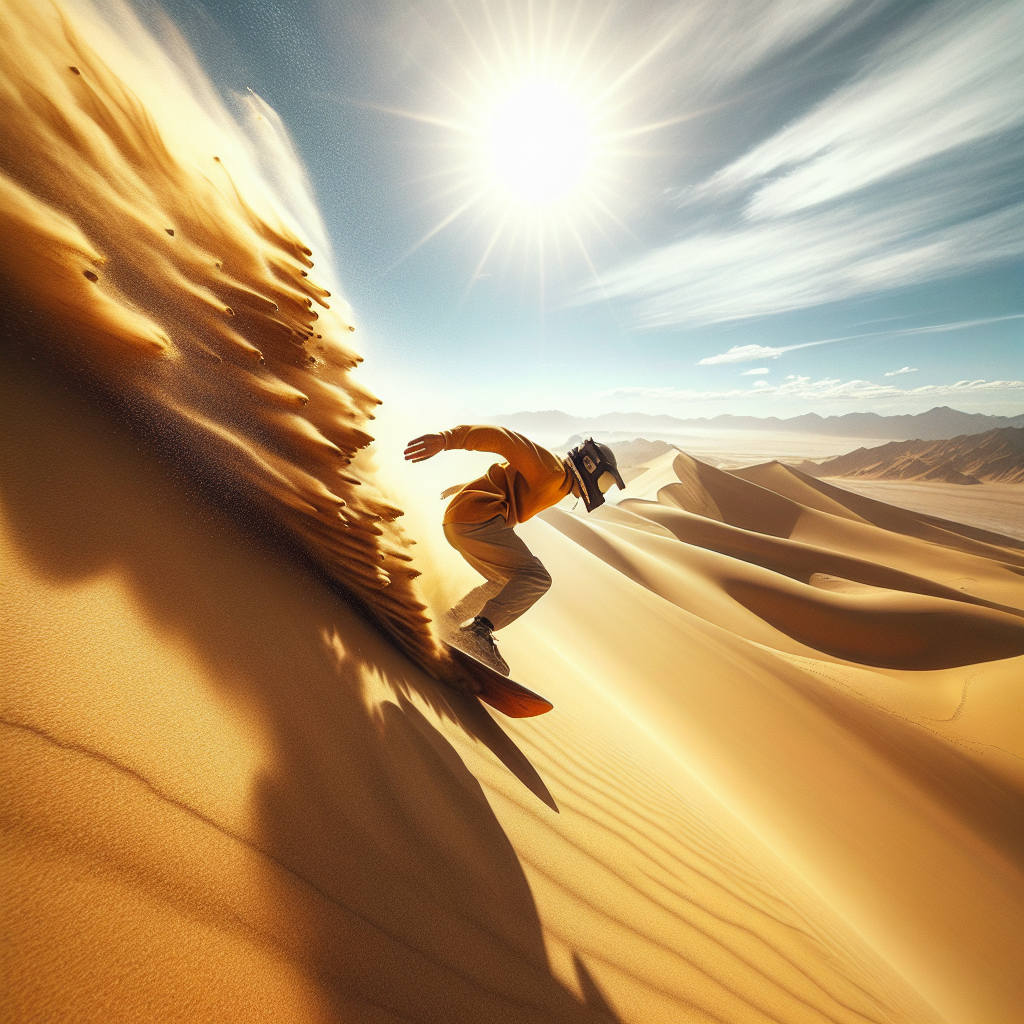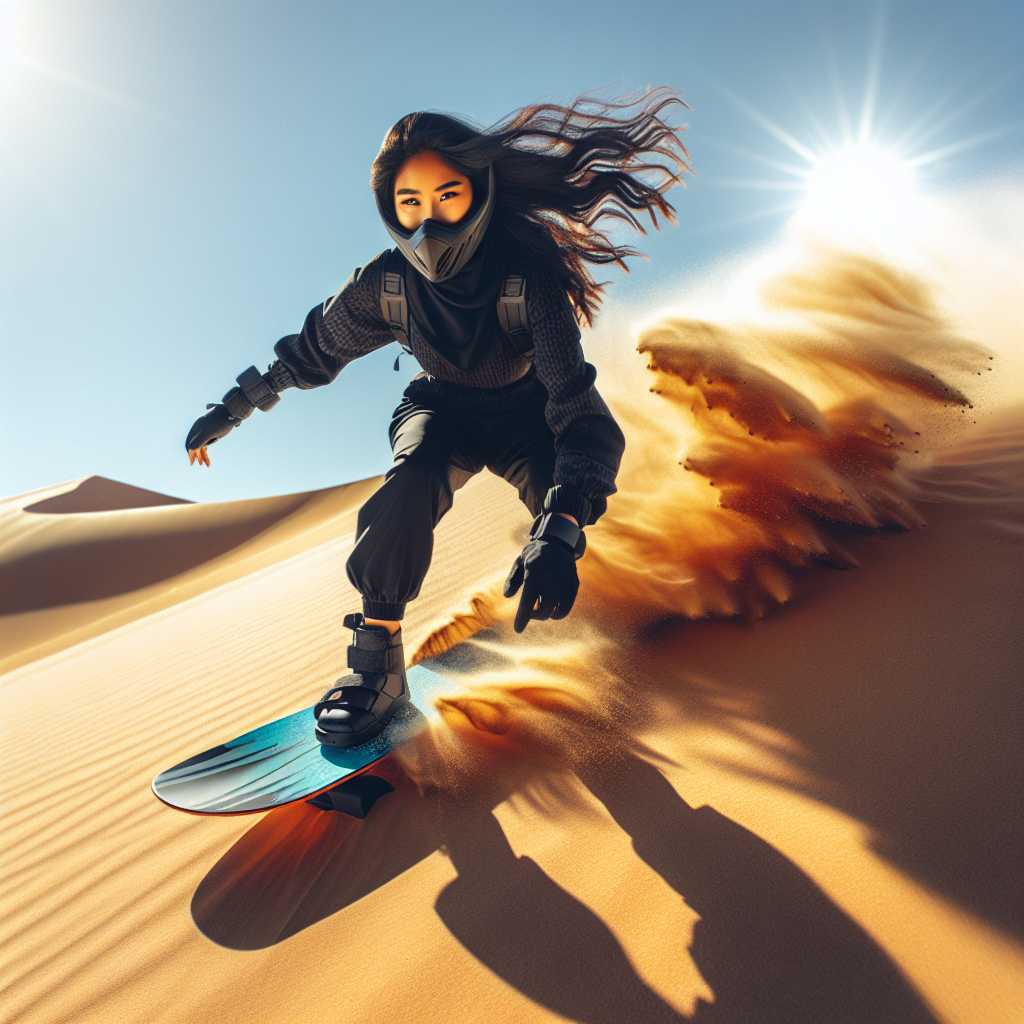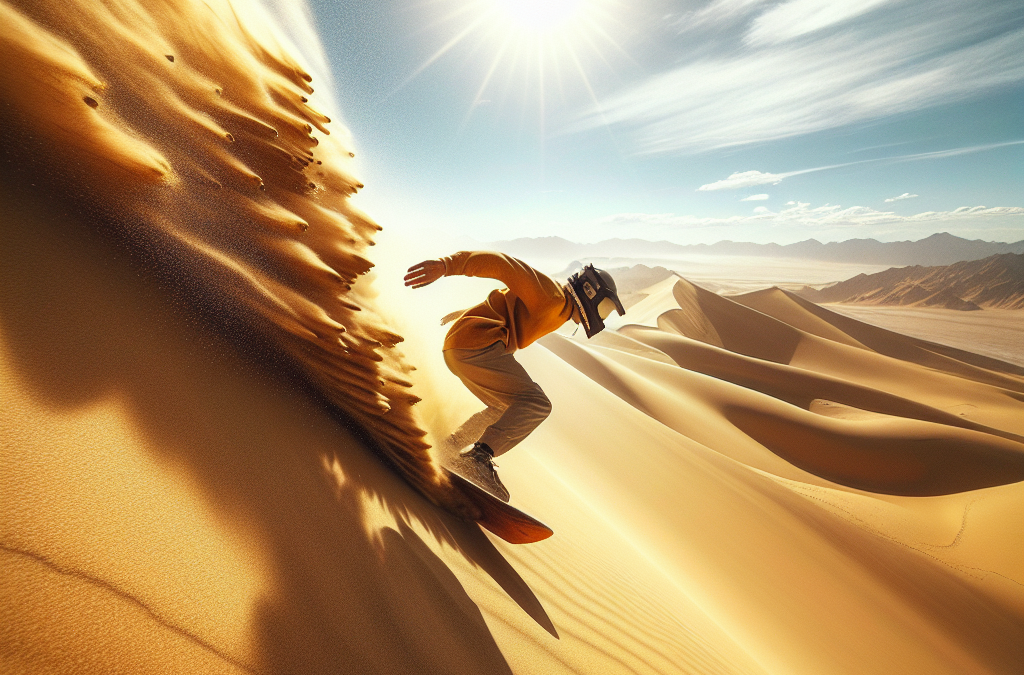Say goodbye to your fear of heights and conquer your adventurous spirit as you explore the realm of sandboarding, the desert’s most thrilling sport. This engaging article presents a thrilling journey through the dynamics and the adrenaline-fueling charm of sandboarding. Imagine the soft desert sands beneath your feet and the endless golden horizon stretching out before you as you feel the exhilarating rush of carving down endless dunes. Be ready to embark on a journey like no other, where there’s more to the desert than meets the eye.
Understanding Sandboarding
Overview of sandboarding
Sandboarding is a thrilling recreational activity that has gained popularity over the last few decades. It’s similar to snowboarding in many ways, but with one key difference: it’s done on sand dunes instead of snow-covered slopes. People of all ages can enjoy sandboarding, and it can be as leisurely or as thrilling as you want it to be. Riders strap their feet onto boards and glide down dunes, offering a similar thrill to snowboarding but in warmer climates and without the need for a snowsuit.
Difference between snowboarding and sandboarding
While both snowboarding and sandboarding involve a similar action of sliding down a slope, there are key differences between these two sports. The primary difference lies in the elements – snow and sand. Snow is much smoother and allows for a faster descent, whereas sand has more resistance, making rides slower and more exhausting. Another difference is the equipment; sandboards are specifically designed to slide on sand and are usually waxed to reduce friction.
Evolution and history of sandboarding
While the exact origins of sandboarding are difficult to trace, it’s believed to have been practiced for centuries by indigenous cultures. In modern times, it was initially seen as a form of entertainment for tourists in desert areas. Over the years, it evolved into a full-fledged sport, with dedicated practitioners and competitions worldwide. Despite its relative newness as a recognized sport, sandboarding is growing rapidly in popularity and continues to evolve.
Equipment Needed for Sandboarding
Types of sandboards
Just like in snowboarding, there are different types of sandboards designed for various types of riding. Traditional sandboards are akin to snowboards, designed for standing and with bindings to secure your feet. Sand sleds, typically used for sitting or lying down, offer an alternative, more leisurely way to experience sandboarding.
Proper clothing and gear
While sandboarding doesn’t require heavy winter gear like snowboarding, appropriate clothing and gear are still essential for a safe and enjoyable experience. Light, breathable clothes are advised, along with sturdy shoes. Eye protection like sunglasses or goggles are also important to protect your eyes from the sand. Also, don’t forget sunscreen, as desert environments can be tough on unprotected skin.
Maintenance and care for equipment
Just like any other sports equipment, sandboards need occasional maintenance to keep them in great shape. Regular cleaning after use helps keep sand from damaging the board. Also, sandboards should be waxed regularly to decrease friction and increase their lifespan.
Choosing the right equipment based on your skill level
As a beginner, it’s essential to choose a beginner-friendly board with good stability and control. As you gain more confidence and improve your skills, you may opt for a board designed for more speed and maneuverability. It’s always advised to seek advice from experienced sandboarders or professionals in choosing the right equipment for your skill level.

Learning How to Sandboard
Basic techniques and skills
Just like any other sport, sandboarding requires learning basic skills and techniques. This includes how to stand and balance on the board, how to steer and control your speed, and how to stop safely. As you advance, you may learn more complex moves like jumps and spins.
Training and practice advice
As with any other sport, practice is key to becoming proficient at sandboarding. Start by practicing on smaller dunes before progressing to larger ones. It’s also beneficial to take a few lessons from experienced sandboarders or instructors.
Common mistakes and how to avoid them
One common mistake beginner sandboarders make is standing too rigid on the board. Try to keep a relaxed, slightly bent position to absorb shocks and maintain balance. Another common mistake is not leaning sufficiently into turns; remember to shift your weight into the direction you want to go.
Progression in sandboarding skills
Progression in sandboarding, like any other sport, comes with time and consistent practice. As your confidence grows, you’ll be able to tackle larger dunes and try more advanced techniques. Always remember to challenge yourself, but don’t push your limits dangerously.
Safety Measures for Sandboarding
Importance of safety in sandboarding
While sandboarding is a lot of fun, it’s not without risks. Falling on sand can be just as painful as on snow, and speed can lead to serious injury if not managed well. Therefore, safety should be your utmost priority while sandboarding.
Use of safety equipment
Just like snowboarding, protective gear can help reduce the risk of injury while sandboarding. Helmets, knee pads, and wrist guards can protect you from bumps and falls. Plus, goggles will protect your eyes from sand.
Managing and controlling speed
Speed control is key in sandboarding to avoid losing control and having accidents. Beginners should start slow and learn techniques to control their speed. As your skills improve, you’ll become more proficient at managing high speeds safely.
Avoiding common accidents and injuries
The most common accidents and injuries in sandboarding arise from falls. To avoid them, it’s essential to know how to fall properly— try to keep your body loose and roll with the fall instead of resisting it. A great shield against injuries is learning proper techniques and practices under the guidance of experienced sandboarders or instructors.

Locations for Sandboarding
Best sandboarding locations worldwide
There are fantastic sandboarding locations scattered across the world. From the vast dunes of Africa’s Sahara desert to the towering sand hills of Australia’s Lancelin Sand Dunes, and the impressive dunes of South America’s Atacama Desert, there are various regions to explore, each offering unique sandboarding experiences.
Differences between various sandboarding sites
Different sandboarding sites offer different experiences based on the characteristics of their sand dunes. Some sites are known for their high dunes, which are perfect for thrill-seekers, while others have more gentle slopes suitable for beginners or those looking for a less adrenaline-fueled ride. The texture of the sand can also vary between locations, which can affect speed and maneuverability.
Necessary preparations for different locations
Before you go sandboarding, research the specific conditions and requirements of the location you choose. This may include getting relevant permissions, understanding the weather and temperature, checking if you need to bring your own equipment, and knowing the best time of day to ride to avoid extreme heat.
Popular Sandboarding Events
Major competitions and festivals
Sandboarding has sparked a range of competitions and festivals worldwide. These events are a great opportunity to watch experienced riders perform impressive tricks, learn about the latest equipment, and immerse yourself in the sandboarding community.
Famous athletes in sandboarding
Like any other sport, sandboarding has its arena of stars. These are the individuals who have pushed the boundaries of sandboarding with their skills, creativity, and fearlessness. Just as you might have your favorite soccer or basketball player, finding a sandboarding athlete to admire can help inspire your own journey in the sport.
Spectating sandboarding: what to know and expect
Watching sandboarding as a spectator is an exhilarating experience. Be prepared for an action-packed event full of thrills and spills. However, don’t forget to bring the essential gear for desert conditions, such as hats, sunglasses, sunscreen, and plenty of water.
Challenges of Sandboarding
Physical challenges in sandboarding
Sandboarding is a physically demanding sport. It involves navigating the tough terrains of the desert, maintaining balance and control while descending at high speeds, and hiking back up the steep dunes. Practicing regularly helps improve endurance and overall strength, preparing you better for the sport.
Environmental obstacles
Environmental factors such as strong winds, extreme heat, and rough sand conditions can pose significant obstacles in sandboarding. It’s essential to check the weather forecast, understand the terrain, and adjust your techniques and equipment accordingly.
Managing fear and uncertainty in sandboarding
As an extreme sport, sandboarding can be daunting. The high speeds, steep slopes, and physical exertion can spark fear and uncertainty. However, these feelings can be managed and often become less intense with practice, training, and exposure to the sport.
Benefits of Sandboarding
Physical benefits
Sandboarding offers a myriad of physical benefits. It’s a great way to improve balance, enhance core strength, boost stamina, and promote full-body coordination. It also presents the opportunity for an exciting, outdoor workout.
Mental and emotional benefits
Sandboarding can also reward you with mental and emotional benefits. Conquering fears, pushing physical boundaries, and mastering new skills contribute to increased self-confidence and resilience. What’s more, the thrill of speeding down a sand dune can bring great joy and relieve stress.
Skill development through sandboarding
Beyond the physical and mental workout, sandboarding helps build practical skills. For instance, learning to navigate challenging terrains and mastering various control techniques can enhance your decision-making and problem-solving abilities. The sport also promotes patience and perseverance as it takes time and practice to master.
Preserving the Environment While Sandboarding
Environmental impact of sandboarding
Like other sports practiced in natural settings, sandboarding can have an impact on the environment. The activity can contribute to erosion, disturb wildlife, and leave litter behind. Thus, it’s imperative to practice sandboarding responsibly.
Techniques for environmentally-friendly sandboarding
There are several ways to make sandboarding more environmentally friendly. Sticking to designated sandboarding areas ensures you aren’t harming local ecosystems. Additionally, always carrying out any trash or litter you bring in and encouraging others to do the same helps keep the sand dunes clean.
Organizations promoting responsible sandboarding
Several organizations worldwide are dedicated to promoting responsible sandboarding practices. They carry out work to educate sandboarders on the importance of preserving sand dune ecosystems and ensuring the continued availability of these unique areas for the sport.
Getting Started in Sandboarding
Investment needed in gear and equipment
Getting started in sandboarding requires an initial investment in gear and equipment. This includes a sandboard, protective gear like a helmet and goggles, and suitable clothing. Remember, it’s not necessary to buy the most expensive equipment when starting out. Start with a beginner-level board and upgrade as your skills progress.
Finding and joining a local sandboarding community
A great way to immerse yourself in sandboarding is to find and join a local community or club. This will provide opportunities to learn from more experienced riders, have someone to practice with, and gain guidance on best practices in the sport.
Steps to take for beginners in sandboarding
If you’re a beginner, start by learning the basics, such as getting the right gear, learning how to stand and balance on a sandboard, and understanding how to control your speed. Taking lessons from an experienced instructor can be very beneficial. Remember, practice makes perfect, so don’t be too hard on yourself at first!
Future of sandboarding
The future of sandboarding looks bright. As more people discover this exciting sport, the community continues to grow. Advancements in equipment, increased media coverage, and the addition of more sandboarding parks and resorts all point towards an exciting future for this thrilling desert sport.

